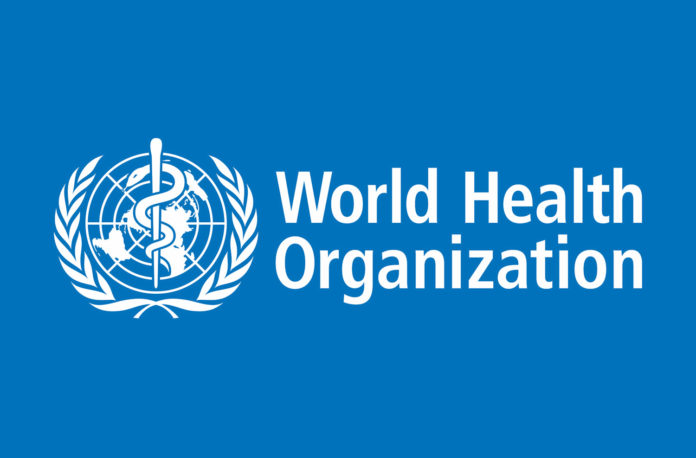India at WHO SEARO
Dr. Bharati Pravin Pawar discusses India’s challenges and opportunities during the COVID-19 Pandemic at the WHO SEARO Ministerial Roundtable
“With a decentralized but unified, whole of government approach, we focused on rapidly creating COVID dedicated infrastructure and upskilling our healthcare workforce”
By PIB Delhi
Union Minister of State for Health and Family Welfare Dr. Bharati Pravin Pawar represented India at the World Health Organization- South East Asia Regional Office (WHO-SEARO) through video-conference here today. She offered intervention on behalf of India at the Ministerial Roundtable for the Seventy-fourth Session of the WHO Regional Committee, for South-East Asia.
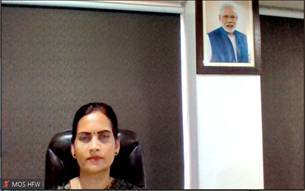
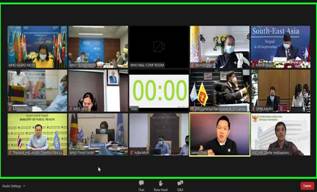
She highlighted the key measures and strategies planned to ‘build back better’ to achieve Universal Health Care and health related Sustainable Development Goals and to strengthen health system resilience for the future.
Acknowledging that the COVID-19 pandemic has affected virtually every sphere of life affecting lives and livelihoods alike apart from causing huge loss of lives, she said, “Guided by Hon’ble Prime Minister of India, country adopted a proactive, pre-emptive, whole of Government, whole of society and people-centric approach to manage the pandemic. Our preparedness and response strategies utilized our past experiences of managing public health emergencies and contemporary scientific knowledge about evolving nature of disease to decide requisite public health interventions. India’s strategy for fighting the pandemic is built on five pillars – Test, Track, Treat, Vaccinate and adherence to Covid Appropriate Behavior. With a decentralized but unified, whole of government approach, we focused on rapidly creating COVID dedicated infrastructure and upskilling our healthcare workforce.”
She noted the proactive bold decisions by India’s strong and decisive leadership like surveillance at points of entry slowed down the entry and spread of COVID-19 and gave enough time for the country to build public health capacities& infrastructure to effectively manage the pandemic. Inter-sectoral coordination facilitated by establishing high level inter-ministerial groups and communication with states, other stakeholders and community at large facilitated a Jan Andolan (people’s movement) for managing the pandemic. Legal and policy provisions like The Epidemic Diseases (Amendment) Act, 2020; Disaster Management Act, 2005 already available to the Union and sub-national jurisdictions, provided the enabling framework to operationalize all aspect of pandemic management by clarifying roles, responsibilities while facilitating inter-sectoral coordination as governance from national to local levels. Further, technical support by Union Government on containment, treatment protocol and all aspects of Covid management ensured a unified response.
Government of India regularly monitored the evolving nature of disease and it’s spread across the nation and in different parts of the world to aid field action, based on varied trajectory of pandemic across various geographical regions of the country.
Specific efforts to strengthen the core capacities in terms of laboratory, hospital infrastructure, R & D on diagnostics, vaccines, essential logistic and upgradation of human resources were undertaken along with the development of indigenous capacities in terms of essential logistics including personal protective equipment, diagnostics, ventilators and vaccine manufacturing capacities. Similarly digital innovations like ICMR Testing Portal aided monitoring of trajectory of infection across the country; IT applications like “AarogyaSetu” supported contact tracing and COWIN monitored the mammoth vaccination efforts; tele-medicine and e-ICU improved outreach to patients for both COVID and non-COVID essential health services.
Speaking on the human cost of the Pandemic, she observed, “Realizing the indirect impact of COVID-19 especially on the poor and marginalized sections of society, a number of social security measures including supply of food grains, minimum income support schemes, support for small industries, support for children who have lost their parents due to COVID-19 and other economic measures were taken to mitigate the impact of COVID-19.”
On the massive implication of India’s development and deployment of vaccines along with amplification of production capacities on Global health, she shared the fundamental principles of India’s vaccination strategy: augmenting production of vaccines, prioritising vulnerable groups for vaccination, making efforts in procurement of vaccines from other countries, monitoring all vaccinated people for their second dose, as well as providing requisite digital vaccination certificate.
She said, “Our National Expert Group on Vaccine Administration for COVID-19 provides guidance on vaccine trials, equitable distribution of vaccine, procurements, financing, delivery mechanisms, prioritization of population groups etc. and the National Task Force on Vaccine Development supports Research and Development of Drug, Diagnostics and Vaccines for Coronavirus.” Detailing the phase wise opening of vaccination for targeted segments, she informed that India has crossed the 680 million mark in vaccinating India’s population.
India utilized the existing infrastructure of the Universal Immunization Programme which was augmented to ensure cold chain maintenance besides managing required logistics of vaccines and syringes. Capacity Building at all level was taken up by duly training more than 7,600 participants at state level and around 61,500 at district level apart from training more than 2 lakh vaccinators and 3.9 lakh other vaccination team members. To enhance vaccine production, financial support as grant was provided to vaccine manufacturers, advance payment for orders placed, permission for at-risk manufacturing was allowed besides focusing on technology transfer to aid production. Co-WIN digital platform supported transparent registration and tracking of every beneficiary for COVID-19 vaccination along with real time information on the available stocks of vaccine, their storage temperature, digital certificates.
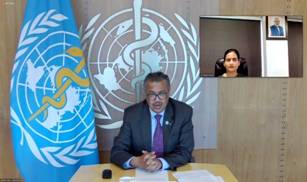
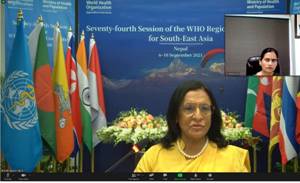
She ended her speech pointing out that India’s COVID-19 vaccination programme demonstrates how detailed planning involving all stakeholders, effective communication of operational plan, robust supply chain management, use of technology, adaptive program implementation can achieve such a herculean task in an efficient manner.












